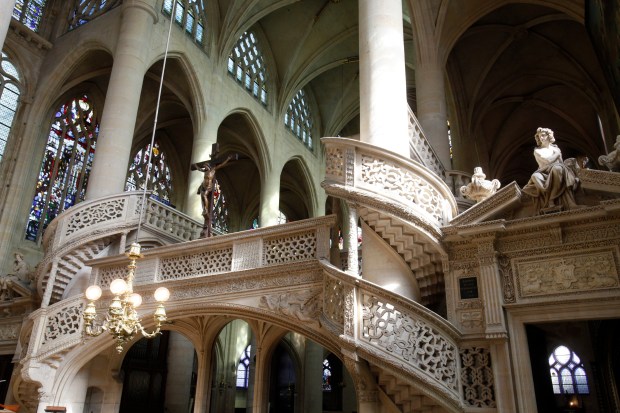In Paris, the church of Saint-Étienne-du-Mont (St. Stephen of the Mountain) occupies a prestigious position. It was built next to the church of Sainte-Geneviève, on the mountain of the same name, when the earlier church had become too small to accommodate all the pilgrims who came to venerate the relics of St. Geneviève, the patron saint of Paris. The old church of Sainte-Geneviève has since been demolished, and the saint's relics were transferred to Saint-Étienne-du-Mont.
The most remarkable feature of this church is its rood screen. Built in the early 16th century, it’s the only surviving rood screen in Paris. In the Middle Ages, the rood screen separated the choir, where the monks and canons sat, from the nave, where the laity stood. It also served as a platform from which to proclaim the Word of God. The rood screen is thus built like a walkway between two pillars. In fact, the name rood screen in French — “jubé” — comes from the beginning of the prayer addressed to the celebrant by the deacon before reading the Gospel: "Jube, domine, benedicere...": "Bless me, O Lord…"
The first rood screens date back to the 12th century, and this type of platform was common in churches until the 16th century.

A rood screen that “should have” disappeared
At the time of the Council of Trent, there was a growing desire to make the Mass visible to all. In order to open up the choir to the nave, rood screens began to be destroyed. Almost all of them in France disappeared in the 17th century, gradually replaced by pulpits for homilies.
The rood screen at Saint-Étienne-du-Mont is one of the survivors. However, it was almost demolished in the 18th century at the request of parishioners, in a bid to modernize their church. Perhaps it was the prospect of a loss of income for the parish that saved the rood screen: private individuals used to rent space on its gallery!

The rood screen, built in the mid-16th century, is decorated in the Renaissance style. The balustrade is a lacy stone screen, carved from Saint-Leu limestone. Two clerestory staircases wind around the pillars. A gallery, a rather unusual feature, extends the rood screen on either side of the choir. Originally, the gallery was used to hang tapestries depicting the life of St. Stephen on feast days.

On the nave side, the platform rests on a 29.5-foot-wide "basket-handle" arch; on the choir side, it is supported by three arches. On either side of the platform is a statue of a woman, an allegory of Fame. The one on the right is holding olive branches; the other on the left, a crown of oak leaves. They have replaced the angels bearing the Passion nails and crown of thorns. The Christian symbols were replaced by those of the Republic during the French Revolution.

The rood screen thus bears witness to the period when the church was transformed into a temple of filial piety, for a new cult, theophilanthropy. It was returned to its parish church function in 1801. Although the names of most of the craftsmen involved in the church's construction are known, the author of this masterpiece remains a mystery.




